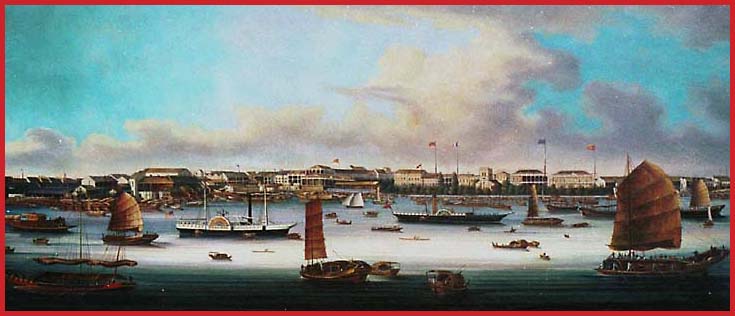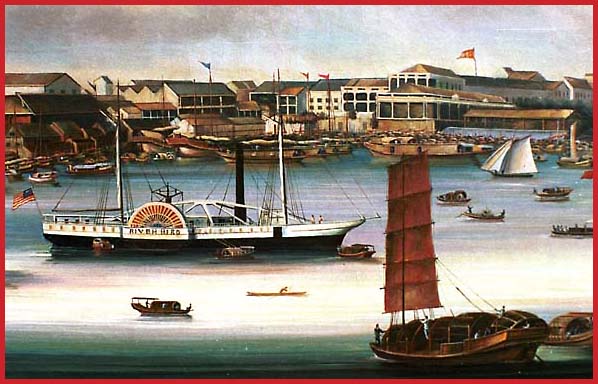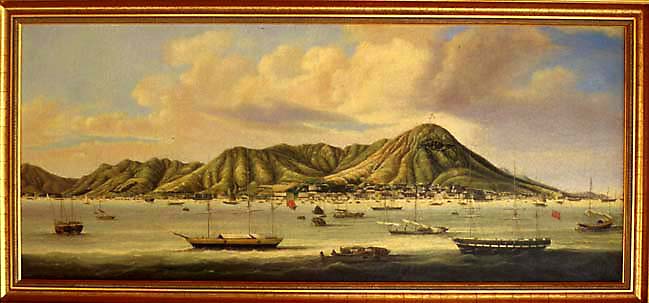
The "13 Hongs" on Shamian
island,- Guangzhou
as seen from
"My China Room"
(part 3)
The China trade paintings in my China Room
are very cleverly made copies - - -
The originals are all hanging in the Hong
Kong Museum of Art, and ,- needless to say-, they are priceless.
But as mentioned earlier, - my copies are
so well made-, that it is hard to tell the difference between them and
the originals - - --
And what a story those paintings tell -
- -
When the Portuguese first arrived in China
in 1557, they found an empire which in many ways was far more advanced
than the Europe they came from.
The Chinese were very much aware of that,
and as the most natural thing, they expected the intruders to adapt to
the superior culture and standards of the "Middle Empire".
But the Chinese were not really interested
in trade with the Europeans, because ,- as the Emperor said-, China had
everything it needed within its borders.
Therefore China did not have any use of
anything Europe could produce - - -
This was probably very true,- but the Europeans
looked at it in a completely different way - - -
And the Chinese totally underestimated the
"Foreign Devils" .
First of all,- the Europeans did not adapt
to the Chinese ways,- and furthermore they desperately wanted to lay their
hands on all the magnificent goods that China could produce, - so they
insisted on trade - - -
Eventually the Chinese gave in, and in 1685
trade was finally opened at Guangzhou,- a city at the Pearl River.
Warehouses were established nearby, and
finally the "Foreign Devils" could ship out their silk and tea in large
quantities.
In those days Guangzhou was considered to
be situated at the out most frontier of the Chinese empire,- far away from
the "real" Chinese civilization-, so the bad influence from the "Foreign
Devils" were avoided by cleverly selecting that remote place as trading
station - - -
In the early days, the Europeans were the
weaker part in the trade exchange.
They had to pay very well for the Chinese
goods, - with pure silver-, but things changed - - - -
In 1757 the Chinese wanted more control
with the trade and the foreigners,- and restricted the trade to a single
merchants' guild situated on a small island,- Shamian-, where the foreign
traders were allowed to do their business.
They were not allowed outside the area,-
and were not allowed to have any contact with the Chinese people, except
for the officials that controlled the trade.
Thus the famous "13 Hongs" were born - --
The "Hongs" were trading houses,- or "factories"
as they were called - - -
Here the major seafaring nations from the
Western world could trade,- and they could be completely controlled by
the Chinese authorities - - -
Those nations were besides Denmark,- also
Spain, France, USA, Austria, Sweden, England and Holland.
But let us have a look at my paintings,-
and see what it looked like in those days - -
First a classic painting of the "13 Hongs"
showing the Guangzhou factories facing the Pearl river - -

The "13 Hongs" on Shamian
island,- Guangzhou
This scene shows what it looked like in 1855
or 1856 - - -
The traffic on the Pearl River is extremely
intensive with a lot of small boats and Chinese junks everywhere - -

The Danish factory - -
Here is a small section of the painting,-
showing the Danish factory just above the sail of the Chinese junk.
Also you can see a Western paddle wheeler,-
the "River Bird"-, an American passenger-cargo vessel that sailed between
Guangzhou and Hong Kong in those days - - -
What you do not see, are the big clipper
ships - - -
The reason for this is,- that the Chinese
authorities did not allow them to go all the way up to Guangzhou.
The ships and their big crews were not wanted
in the restricted trade zone.
Also it would not be possible for most of
them because of draft restrictions in the river.
Therefore the Western ships were moored at
Huangpu,- an island a little further down the river.
Here the cargoes were transferred to Chinese
junks, and sailed up to the factories where the actual trade took place
- - - -
In my collection I also have a picture showing
this well known place from the great age of sail.

The Huangpu anchorage,- and
Dane's Island - - -
Here it is,- Huangpu-, and the year is 1850
- - - -
Huangpu island is seen in the middle of
the picture,- and the famous Huangpu pagoda can be seen in the distance
- - - -
In the foreground you see Dane's Island,-
which was used as burial ground for those sailors that did not survive
the trip to China.
(Click to find the link to "The
Lost Graves on Dane's Island.")
An island to the left of Dane's Island was called French Island,- and it has been suggested, that the Danes and the French enjoyed special privileges,- and had special good relation to the Chinese authorities,- since they had islands named after them.
However,- nothing supports that theory -
- -
All Western nations were treated equal,-
and all had to follow the same rules.
The Chinese had organized the trade down
to even the smallest detail,- and in a very professional and orderly manner.
One of the manifestations of that was,-
that the foreign ships had to be anchored in groups according to their
nationality - - -
Therefore,- the island where the Danish
ships had to anchor-, was called Dane's Island,- and where the French ships
were moored,- the nearby island was called French Island - - -
But things changed - - -
The Western nations started to protest against
this bureaucratic and restrictive way of doing things.
They wanted China to open for free trade
with the rest of the world - - -
But the Chinese were not interested - -
-
They never adapted themselves to modern
times,- and eventually the encounter with the European military might,
became a disaster for the Chinese Empire.
In this power struggle,- the Chinese now
became the loosing part.
The Chinese were forced to accept opium
as payment instead of silver.
That step changed the trade balance tremendously
in favour of the Westerners and fortunes were made in the opium trade.
China got opium,- and was drained for silver!
A real bad deal - - -
The Chinese Emperor was alarmed by this,-
and also by the growing number of opium addicts.
This was totally unacceptable,- and something
had to be done about it!
Therefore,- a Chinese force surrounded the
British in Guangzhou,- cut out their food supply-, and demanded the surrender
of all opium in their possession - - -
The British tried to hold out,- but in the
end they had to surrender 20.000 boxes of opium.
This was in 1839 - - -
But the British,- who were by far the most
aggressive and ruthless of the Western trading powers-, wanted to solve
the trade problem, - and they wanted to acquire a stronghold at the China
coast, where they could develop and protect their interests - - -
They retaliated violently with a military
action,- that was later referred to as the "Opium War" - - -
And in this war,- the British Crown Colony Hong Kong was born - - -
One fine day,- on the 26th. of January 1841-,
a contingent of Royal Navy men went ashore on Hong Kong island,- and claimed
it for the British Crown - - -
Finally the British Empire had extended
its spider web to the China coast - - - -
That brings us to my last China Trade paintings,-
Hong Kong in its early days.

British Crown Colony Hong
Kong
Here it is,- Hong Kong island as it looked
in 1854 -, as seen from Kowloon peninsula - - -
Hong Kong was rapidly emerging as an important
trading port,- and the port is full of ships.
Also ashore there are clear signs of hectic
activity,- with many major buildings already completed.
This position,- as one of the worlds greatest
trade centers-, has been maintained up to this day.
More military actions between England and
China took place later on, and China still has scars from that time.
Last year,- year 2000 -, I had the good
fortune to visit Beijing,- and it is very sad to see priceless cultural
assets,- without any military value-, totally destroyed and in ruins
to this day, after a senseless and totally unnecessary destruction carried
out by combined British and French forces - - -
And it was only done for greed,- greed for
silver and power,- and for building the Empire - -
However,- other completely destroyed cultural
assets,- like the famous Suzhou Street at the Summer Palace-, has been
beautifully restored to its former glory after it was totally wrecked in
1860.
Yes,- the story of the China trade is indeed very exiting and violent,- and for not so long time ago I suddenly realized,- that the events that started with the arrival of the Portuguese in 1557-, has a red line attached to it, which leads directly to my own activities in Hong Kong and the China Coast in the first half of the 1970'es, when I served on Denmark's last China trader,- the "Emma Jebsen" of Aabenraa,- owned by well known China traders,- Jebsen & Co. - - - -
That opens up for the story about the ship owners and sailors from Aabenraa, - and about the master shipbuilders, who turned out the biggest and fastest clipper ships,- not only in Denmark, but in all of Scandinavia.
They made Aabenraa another unique maritime community.
Therefore I will tell something about "EMMA
JEBSEN",- my favorite ship-, it's owners ,- famous China traders
JEBSEN & CO. of Aabenraa-, and something more about the town of AABENRAA
itself, where once shipbuilding was perfected, and world-wide shipping
was the main trade for about 150 year ago - - -
AABENRAA
- another special maritime town
"EMMA JEBSEN"
- Denmark's last China trader
Updated: August 1st. 2001